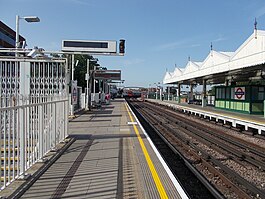Putney Bridge tube station
| Putney Bridge | |
|---|---|
 | |
| Location | Fulham |
| Local authority | London Borough of Hammersmith and Fulham |
| Managed by | London Underground |
| Number of platforms | 2 |
| Fare zone | 2 |
| London Underground annual entry and exit | |
| 2018 | |
| 2019 | |
| 2020 | |
| 2021 | |
| 2022 | |
| Railway companies | |
| Original company | District Railway |
| Key dates | |
| 1 March 1880 | Opened as Putney Bridge & Fulham; terminus of line |
| 3 June 1889 | Line extended to Wimbledon |
| 1 September 1902 | Renamed Putney Bridge & Hurlingham |
| 1932 | Renamed Putney Bridge |
| Other information | |
| External links | |
| WGS84 | 51°28′5.85″N 0°12′31.5″W / 51.4682917°N 0.208750°W |
Putney Bridge is a London Underground station on the Wimbledon branch of the District line. It is between Parsons Green and East Putney stations and is in Zone 2. The station is located in the south of Fulham, adjacent to Fulham High Street and New Kings Road (A308) and is a short distance from the north end of Putney Bridge from which it takes its name.
History[edit]
The station was opened on 1 March 1880 as Putney Bridge & Fulham when the District Railway (DR, now the District line) extended its line south from West Brompton. The station served as the terminus of the line until 1889 when the DR built Fulham Railway Bridge across the River Thames and extended the line south to the London and South Western Railway's (L&SWR's) newly built East Putney station where it connected to the L&SWR's new line to Wimbledon. Services from the station to Wimbledon began on 3 June 1889. The station has an ornate yellow brick façade at the entrance.
On 1 September 1902,[6] the station was renamed Putney Bridge & Hurlingham referring to its proximity to Hurlingham Park and the Hurlingham Club. It received its current name in 1932. Despite taking its name from Putney Bridge, the tube station is in fact on the Fulham side of the Thames and is not actually located in Putney.
Nearby places of interest[edit]
A World War II pillbox can clearly be seen at the Southern end of the Southbound platform, overlooking Fulham Railway Bridge. The concrete pillbox was built in 1940 as a final line of defense should German troops invade London. It was designed like a fortified look-out post with narrow loopholes (rather like a castle) to protect the inhabitant while allowing them to shoot at intruders.[7]
In addition to the Hurlingham club and Hurlingham Park, the Grade I listed Fulham Palace and its restored garden, the former home of the Bishops of London, in Bishop's Park is nearby to the north and contains a small museum. The historic All Saints Church, Fulham and its graveyard are on the riverside route to Fulham Palace.
Fulham Football Club's Craven Cottage stadium is about 1 kilometre to the north-west and the tube station is often very busy on matchdays.
Recent developments[edit]
Putney Bridge had a bay platform (platform 2) which could only accommodate C stock trains and was located between the current eastbound and westbound tracks. After the C stock was removed from service in June 2014, the bay platform ceased to be used, and the track was lifted as of October 2015.
This platform was brought back into use in May 2016. The previous terminating end is now joined to the westbound track and platform 3 is no longer in use and is fenced off. This eliminated the previous 10 mph speed restriction on the westbound side.
Connections[edit]
London Buses routes 14, 22, 39, 85, 93, 74, 220, 265, 270, 378, 414, 424, 430 and night routes N22, N33, N72 and N74 serve the station.[8][9]
Gallery[edit]
-
Putney Bridge underground station platforms (September 2006)
-
The outside of Putney Bridge Station
-
Southern end of the platforms at Putney Bridge station (2007 view), showing the former layout with reversing siding, the World War 2 pillbox defending the bridge, and the northern tip of the bridge
References[edit]
- ^ "Station Usage Data" (CSV). Usage Statistics for London Stations, 2018. Transport for London. 23 September 2020. Archived from the original on 14 January 2023. Retrieved 11 October 2023.
- ^ "Station Usage Data" (XLSX). Usage Statistics for London Stations, 2019. Transport for London. 23 September 2020. Archived from the original on 9 November 2020. Retrieved 9 November 2020.
- ^ "Station Usage Data" (XLSX). Usage Statistics for London Stations, 2020. Transport for London. 16 April 2021. Retrieved 1 January 2022.
- ^ "Station Usage Data" (XLSX). Usage Statistics for London Stations, 2021. Transport for London. 12 July 2022. Retrieved 7 September 2022.
- ^ "Station Usage Data" (XLSX). Usage Statistics for London Stations, 2022. Transport for London. 4 October 2023. Retrieved 10 October 2023.
- ^ Forgotten Stations of Greater London by J.E.Connor and B.Halford
- ^ Wignall, Katie (18 April 2022). "The WWII Relic at Putney Bridge Tube Station". Look Up London Tours. Retrieved 28 December 2022.
- ^ "Buses from Fulham and Putney Bridge" (PDF). TfL. 16 July 2022. Retrieved 15 July 2022.
- ^ "Night buses from Fulham and Putney Bridge" (PDF). TfL. September 2020. Retrieved 25 November 2021.
External links[edit]
| Preceding station | Following station | |||
|---|---|---|---|---|
| East Putney towards Wimbledon
|
District line Wimbledon branch
|
Parsons Green towards Edgware Road or Upminster
| ||




